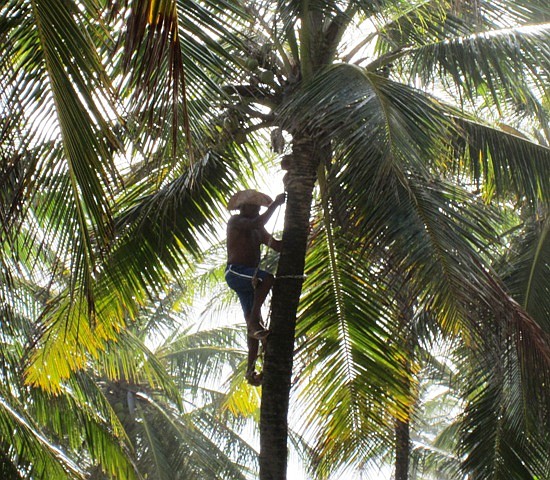 Facebook
Facebook
 X
X
 Instagram
Instagram
 TikTok
TikTok
 Youtube
Youtube

Those who abide in the coastal state of Bahia in northeastern Brazil live according to something like "tidal time": when it ebbs, and it ebbs hundreds of meters, it's time for business; when it flows, it's time to move to town, work in restaurants, play foot-volley, attend mass, or share sub-zero 600ml bottles of beer.
A beach town 54 kilometers north of Salvador (the Bahian capital) is Praia do Forte ("beach of the strong"). The town is also the locus of "Projeto TAMAR,” a Brazilian NGO (ICMBio) that researches, protects and helps manage flourishing sea turtles. The project has garnered local support and inculcated young local Bahians – many of whom do not have too many opportunities – to educate tourists and care for the nesting area.

I experienced four major "hours" in a day in Praia do Forte. There’s the major ebb, which reveals tide pools and reef shelves, and a major flow, which washes up to the breakwaters and sends the beachside barracas (shape-shifting beach bars) to their boardwalk base; then at night are two susurrant tides. The flow is far more unnerving and stirring than the comparatively minor tidal shifts in San Diego. I remember surfing and thinking how radically a tide could change a session; I couldn't imagine it could change the entire culture.
At low tide fishermen walk 200-300 meters out to the shore reefs – natural breakwaters that separate the major shelf from the basin. There are also "natural pools" where tourist lounge, snorkel, putter about in aqua socks or swim. The basic formation of the tide pools remains unique, but the pools are refreshed and repopulated each day. I went for several swims. Each time the water was both warm and fresh; I was buoyed by the saltiness, and wondered (half-unsettled) about all the creatures that had set up camp awaiting the next major flow.
Twenty kilometers north of Praia do Forte is a nearly deserted, largely untouched course of beaches set beside massive expanses of sand dunes, brushed with the mid-Atlantic jungle grass. In front of the one-road beach town, there are few bars on the beach that sell beer, seafood and appetizers and rent umbrellas and beach chairs. I invested in my own umbrella so I could avoid the over-friendly sun.

On the beach were small fishing dinghies made of contiguous pieces of palm timber in the shape of kayaks. Behind the boats we saw a man climbing a palm with a simple but elegant system of ropes that made his vertical "walk" look as seamless as Anansi the Spider, weaving a web to the sky god.
At flow tide, we retreated across two kilometers of pattered white dunes, brushed with the resilient flora of south Atlantic Brazil, and returned to our hotel with its gentle lassitude, chickens, coconuts, beer and people who live, work and play in concert with the tides.


Those who abide in the coastal state of Bahia in northeastern Brazil live according to something like "tidal time": when it ebbs, and it ebbs hundreds of meters, it's time for business; when it flows, it's time to move to town, work in restaurants, play foot-volley, attend mass, or share sub-zero 600ml bottles of beer.
A beach town 54 kilometers north of Salvador (the Bahian capital) is Praia do Forte ("beach of the strong"). The town is also the locus of "Projeto TAMAR,” a Brazilian NGO (ICMBio) that researches, protects and helps manage flourishing sea turtles. The project has garnered local support and inculcated young local Bahians – many of whom do not have too many opportunities – to educate tourists and care for the nesting area.

I experienced four major "hours" in a day in Praia do Forte. There’s the major ebb, which reveals tide pools and reef shelves, and a major flow, which washes up to the breakwaters and sends the beachside barracas (shape-shifting beach bars) to their boardwalk base; then at night are two susurrant tides. The flow is far more unnerving and stirring than the comparatively minor tidal shifts in San Diego. I remember surfing and thinking how radically a tide could change a session; I couldn't imagine it could change the entire culture.
At low tide fishermen walk 200-300 meters out to the shore reefs – natural breakwaters that separate the major shelf from the basin. There are also "natural pools" where tourist lounge, snorkel, putter about in aqua socks or swim. The basic formation of the tide pools remains unique, but the pools are refreshed and repopulated each day. I went for several swims. Each time the water was both warm and fresh; I was buoyed by the saltiness, and wondered (half-unsettled) about all the creatures that had set up camp awaiting the next major flow.
Twenty kilometers north of Praia do Forte is a nearly deserted, largely untouched course of beaches set beside massive expanses of sand dunes, brushed with the mid-Atlantic jungle grass. In front of the one-road beach town, there are few bars on the beach that sell beer, seafood and appetizers and rent umbrellas and beach chairs. I invested in my own umbrella so I could avoid the over-friendly sun.

On the beach were small fishing dinghies made of contiguous pieces of palm timber in the shape of kayaks. Behind the boats we saw a man climbing a palm with a simple but elegant system of ropes that made his vertical "walk" look as seamless as Anansi the Spider, weaving a web to the sky god.
At flow tide, we retreated across two kilometers of pattered white dunes, brushed with the resilient flora of south Atlantic Brazil, and returned to our hotel with its gentle lassitude, chickens, coconuts, beer and people who live, work and play in concert with the tides.
Comments